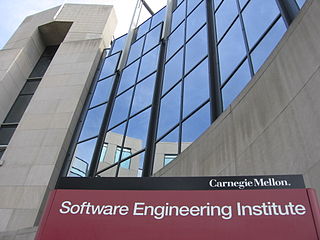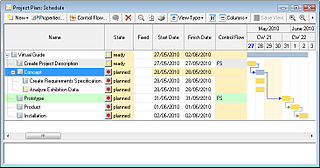Related Research Articles
The Capability Maturity Model (CMM) is a development model created in 1986 after a study of data collected from organizations that contracted with the U.S. Department of Defense, who funded the research. The term "maturity" relates to the degree of formality and optimization of processes, from ad hoc practices, to formally defined steps, to managed result metrics, to active optimization of the processes.

Software Engineering Institute (SEI) is a federally funded research and development center in Pittsburgh, Pennsylvania, United States. Founded in 1984, the institute is now sponsored by the United States Department of Defense and the Office of the Under Secretary of Defense for Research and Engineering, and administrated by Carnegie Mellon University. The activities of the institute cover cybersecurity, software assurance, software engineering and acquisition, and component capabilities critical to the United States Department of Defense.
ISO/IEC 15504Information technology – Process assessment, also termed Software Process Improvement and Capability dEtermination (SPICE), is a set of technical standards documents for the computer software development process and related business management functions. It is one of the joint International Organization for Standardization (ISO) and International Electrotechnical Commission (IEC) standards, which was developed by the ISO and IEC joint subcommittee, ISO/IEC JTC 1/SC 7.
The Personal Software Process (PSP) is a structured software development process that is designed to help software engineers better understand and improve their performance by bringing discipline to the way they develop software and tracking their predicted and actual development of the code. It clearly shows developers how to manage the quality of their products, how to make a sound plan, and how to make commitments. It also offers them the data to justify their plans. They can evaluate their work and suggest improvement direction by analyzing and reviewing development time, defects, and size data. The PSP was created by Watts Humphrey to apply the underlying principles of the Software Engineering Institute's (SEI) Capability Maturity Model (CMM) to the software development practices of a single developer. It claims to give software engineers the process skills necessary to work on a team software process (TSP) team.
Capability Maturity Model Integration (CMMI) is a process level improvement training and appraisal program. Administered by the CMMI Institute, a subsidiary of ISACA, it was developed at Carnegie Mellon University (CMU). It is required by many U.S. Government contracts, especially in software development. CMU claims CMMI can be used to guide process improvement across a project, division, or an entire organization. CMMI defines the following maturity levels for processes: Initial, Managed, Defined, Quantitatively Managed, and Optimizing. Version 2.0 was published in 2018. CMMI is registered in the U.S. Patent and Trademark Office by CMU.
Quality management ensures that an organization, product or service consistently functions well. It has four main components: quality planning, quality assurance, quality control and quality improvement. Quality management is focused not only on product and service quality, but also on the means to achieve it. Quality management, therefore, uses quality assurance and control of processes as well as products to achieve more consistent quality. Quality control is also part of quality management. What a customer wants and is willing to pay for it, determines quality. It is a written or unwritten commitment to a known or unknown consumer in the market. Quality can be defined as how well the product performs its intended function.
Microsoft Solutions Framework (MSF) is a set of principles, models, disciplines, concepts, and guidelines for delivering information technology services from Microsoft. MSF is not limited to developing applications only; it is also applicable to other IT projects like deployment, networking or infrastructure projects. MSF does not force the developer to use a specific methodology.
The Capability Maturity Model Integration (CMMI) defines a process area as, "a cluster of related practices in an area that, when implemented collectively, satisfies a set of goals considered important for making improvement in that area." Both CMMI for Development v1.3 and CMMI for Acquisition v1.3 identify 22 process areas, whereas CMMI for Services v1.3 identifies 24 process areas. Many of the process areas are the same in these three models.
People Capability Maturity Model is a maturity framework that focuses on continuously improving the management and development of the human assets of an organization. It describes an evolutionary improvement path from ad hoc, inconsistently performed practices, to a mature, disciplined, and continuously improving development of the knowledge, skills, and motivation of the workforce that enhances strategic business performance.
A Software Engineering Process Group (SEPG) is an organization's focal point for software process improvement activities. These individuals perform assessments of organizational capability, develop plans to implement needed improvements, coordinate the implementation of those plans, and measure the effectiveness of these efforts. Successful SEPGs require specialized skills and knowledge of many areas outside traditional software engineering.
The Standard CMMI Appraisal Method for Process Improvement (SCAMPI) is the official Software Engineering Institute (SEI) method to provide benchmark-quality ratings relative to Capability Maturity Model Integration (CMMI) models. SCAMPI appraisals are used to identify strengths and weaknesses of current processes, reveal development/acquisition risks, and determine capability and maturity level ratings. They are mostly used either as part of a process improvement program or for rating prospective suppliers. The method defines the appraisal process as consisting of preparation; on-site activities; preliminary observations, findings, and ratings; final reporting; and follow-on activities.
Software sizing or software size estimation is an activity in software engineering that is used to determine or estimate the size of a software application or component in order to be able to implement other software project management activities. Size is an inherent characteristic of a piece of software just like weight is an inherent characteristic of a tangible material.
LeanCMMI is an approach to software engineering process improvement that integrates agile computing methods with process design and deployment for organization's wishing to improve software engineering capability and achieve a maturity level two or three rating based upon the Software Engineering Institute's Capability Maturity Model Integration (CMMI).
An independent test organization is an organization, person, or company that tests products, materials, software, etc. according to agreed requirements. The test organization can be affiliated with the government or universities or can be an independent testing laboratory. They are independent because they are not affiliated with the producer nor the user of the item being tested: no commercial bias is present. These "contract testing" facilities are sometimes called "third party" testing or evaluation facilities.
A maturity model is a framework for measuring an organization's maturity, with maturity being defined as a measurement of the ability of an organization for continuous improvement in a particular discipline. The higher the maturity, the higher will be the chances that incidents or errors will lead to improvements either in the quality or in the use of the resources of the discipline as implemented by the organization.

Roger Redmond Bate was a brigadier general, Rhodes Scholar, professor, and scientist who has held a variety of positions with the Air Force, Texas Instruments, and the Software Engineering Institute at Carnegie Mellon University.
In software engineering, a software development process is a process of dividing software development work into smaller, parallel, or sequential steps or sub-processes to improve design and/or product management. It is also known as a software development life cycle (SDLC). The methodology may include the pre-definition of specific deliverables and artifacts that are created and completed by a project team to develop or maintain an application.

in-STEP BLUE is a project management software program developed and sold by microTOOL GmbH, based in Berlin, Germany. It is designed to assist project managers in developing plans, assigning resources to tasks, tracking progress, managing budgets, requirements, changes and risks as well as analyzing workloads. The tool automatically stores all project results in a central repository shared by all users. Individual project management methods can be supported as well as the agile method Scrum, official methods like the British PRINCE2, the German V-Model XT, the Swiss HERMES method and methods for the automotive industry according to ISO/IEC 15504, also known as SPICE.
Bill Curtis is a software engineer best known for leading the development of the Capability Maturity Model and the People CMM in the Software Engineering Institute at Carnegie Mellon University, and for championing the spread of software process improvement and software measurement globally. In 2007 he was elected a Fellow of the Institute of Electrical and Electronics Engineers (IEEE) for his contributions to software process improvement and measurement. He was named to the 2022 class of ACM Fellows, "for contributions to software process, software measurement, and human factors in software engineering".

Tudor IT Process Assessment (TIPA) is a methodological framework for process assessment. Its first version was published in 2003 by the Public Research Centre Henri Tudor based in Luxembourg. TIPA is now a registered trademark of the Luxembourg Institute of Science and Technology (LIST). TIPA offers a structured approach to determine process capability compared to recognized best practices. TIPA also supports process improvement by providing a gap analysis and proposing improvement recommendations.
References
- ↑ T. Schorsch, "The Capability Im-Maturity Model (CIMM)", U.S. Air Force (CrossTalk Magazine), 1996.
- ↑ A. Finkelstein, A Software Process Immaturity Model, SIGSOFT Software Engineering Notes, 1992.
- ↑ Piney, Kik (c. 2009). "A Project Management Immaturity Model" (PDF). PROject-beneFITS.com.